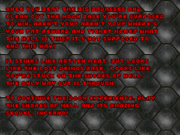No edit summary |
m (→top: clean up) |
||
| (16 intermediate revisions by 12 users not shown) | |||
| Line 1: | Line 1: | ||
| + | [[file:E1_Text_screen.png|thumb|right|The text screen from the end of [[Knee-Deep in the Dead]].]] |
||
| − | {{stub}} |
||
| + | In the [[Doom games]] and derivatives a '''text screen''' is a screen that presents the player with part of the game's story in text form. The text is typed out sequentially, character after character, over a background made from a repeating [[flat]], while music plays. A text screen appears either at the end of an episode (as in [[Doom]]), or after a series of levels (as in [[Doom II]]). The text screen is followed by a picture in Doom, while in Doom II it precedes a level except in the last case, where it is followed by the [[Doom II cast sequence|cast sequence]]. |
||
| ⚫ | [[Doom II]] has text screens before Levels 7, 12, 21, and at the very end(See below), as well as before both secret levels (which are played after Level 15). Both episodes of [[Final Doom]] operate exactly the same way, as they were originally alternate Doom II [[PWAD]]s. The same music is used for all of these text screens from [[The Plutonia Experiment]], with the exception of those of [[TNT: Evilution]], which uses an original, four-second track for the screens. |
||
| − | After completing an episode in DOOM, a screen appears with a few paragraphs of text that describe what has happened in the story so far. After this, a picture is shown. After completing the first/shareware episode ([[Knee-Deep in the Dead]]), the credits screen is shown. After [[The Shores of Hell]] is completed, a picture of Deimos floating above Hell is shown. |
||
| + | [[Heretic]] uses a similar setup as Doom, but [[Hexen]] displays a full-screen picture instead of patterning a flat. [[Strife]], on the other hand, does not use text screens at all, instead using a system of slide shows with voice overs to narrate the story after certain key events. |
||
| − | The third picture, at the end of [[Inferno]], is a scrolling picture that begins with a peaceful view of an Earth field with a rabbit in the foreground, and pans left to show a ruined city with another rabbit's head impaled on a spike. The words "The End" appear and are riddled with bullets. The accompanying [[music]] starts out with a happy little pastorale tune which turns into a disturbing mockery of itself in the [[Wikipedia:Parallel_minor|parallel minor]] key as the ruined city and impaled rabbit head scrolls into view, ending with a mournful [[Wikipedia:twelve-bar blues|twelve-bar blues]]. This music was later re-used for the [[MAP11:_Hunted|11th level]] of [[The Plutonia Experiment]]. |
||
| ⚫ | |||
| − | The fourth picture for [[Thy Flesh Consumed]] shows the same ruined city, but now the marine appears bloody holding his murdered bunny's head. |
||
| + | *[[Episode]] |
||
| ⚫ | [[Doom II]] has text screens before Levels 7, 12, 21, and at the very end, as well as before both secret levels (which are played after Level 15). Both episodes of [[Final Doom]] operate exactly the same way, as they were originally alternate Doom II |
||
| ⚫ | |||
| − | |||
| + | *[[Doom II cast sequence]] |
||
| ⚫ | |||
| ⚫ | |||
[[Category:Gameplay]] |
[[Category:Gameplay]] |
||
Latest revision as of 16:38, 6 August 2019

The text screen from the end of Knee-Deep in the Dead.
In the Doom games and derivatives a text screen is a screen that presents the player with part of the game's story in text form. The text is typed out sequentially, character after character, over a background made from a repeating flat, while music plays. A text screen appears either at the end of an episode (as in Doom), or after a series of levels (as in Doom II). The text screen is followed by a picture in Doom, while in Doom II it precedes a level except in the last case, where it is followed by the cast sequence.
Doom II has text screens before Levels 7, 12, 21, and at the very end(See below), as well as before both secret levels (which are played after Level 15). Both episodes of Final Doom operate exactly the same way, as they were originally alternate Doom II PWADs. The same music is used for all of these text screens from The Plutonia Experiment, with the exception of those of TNT: Evilution, which uses an original, four-second track for the screens.
Heretic uses a similar setup as Doom, but Hexen displays a full-screen picture instead of patterning a flat. Strife, on the other hand, does not use text screens at all, instead using a system of slide shows with voice overs to narrate the story after certain key events.
